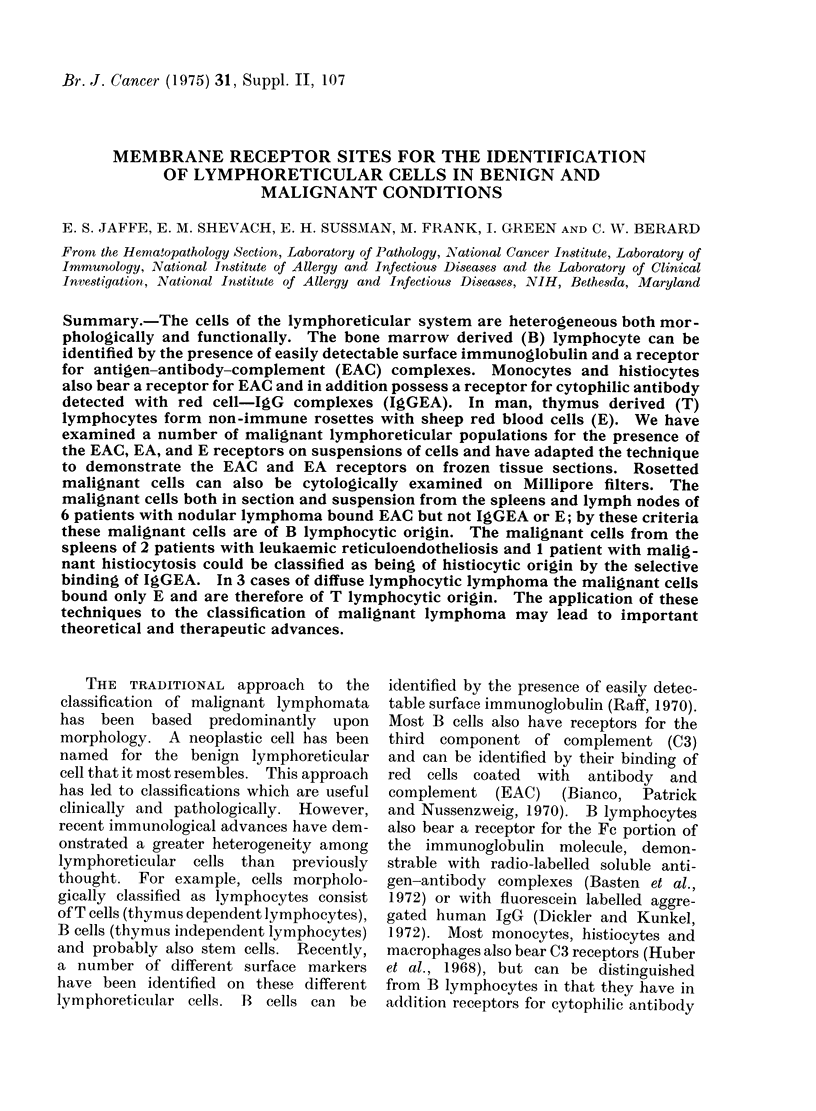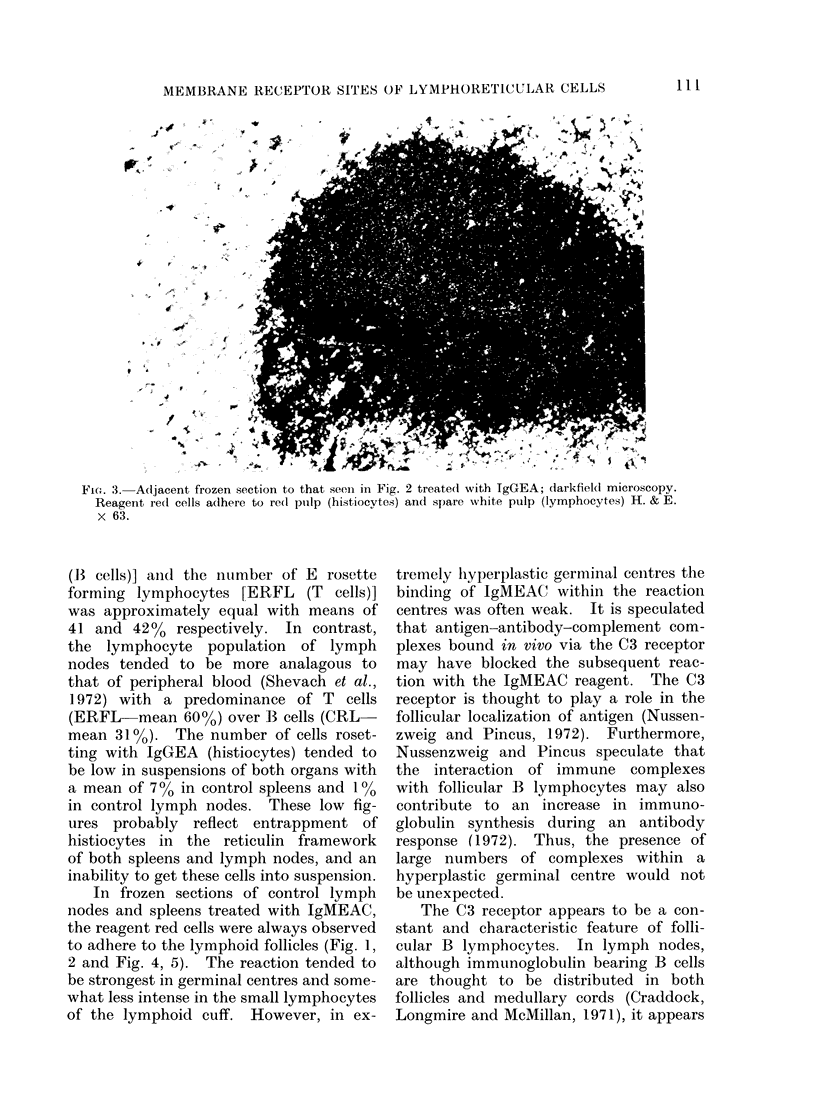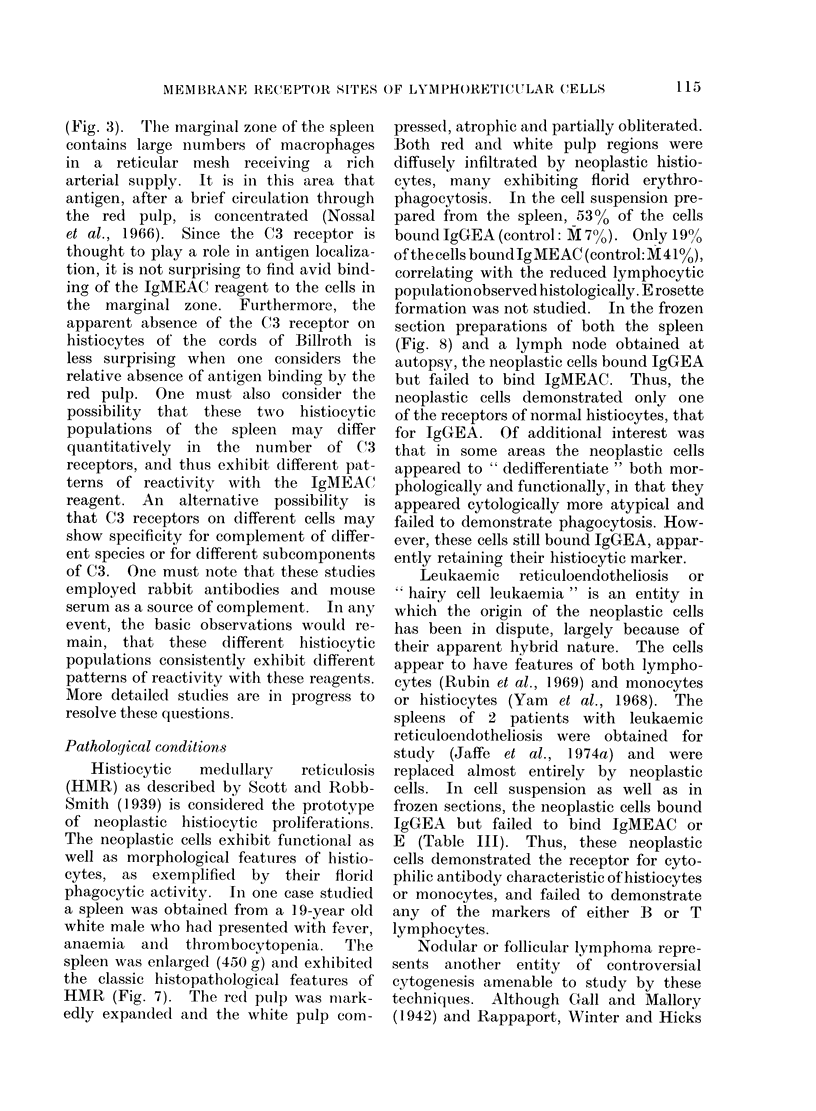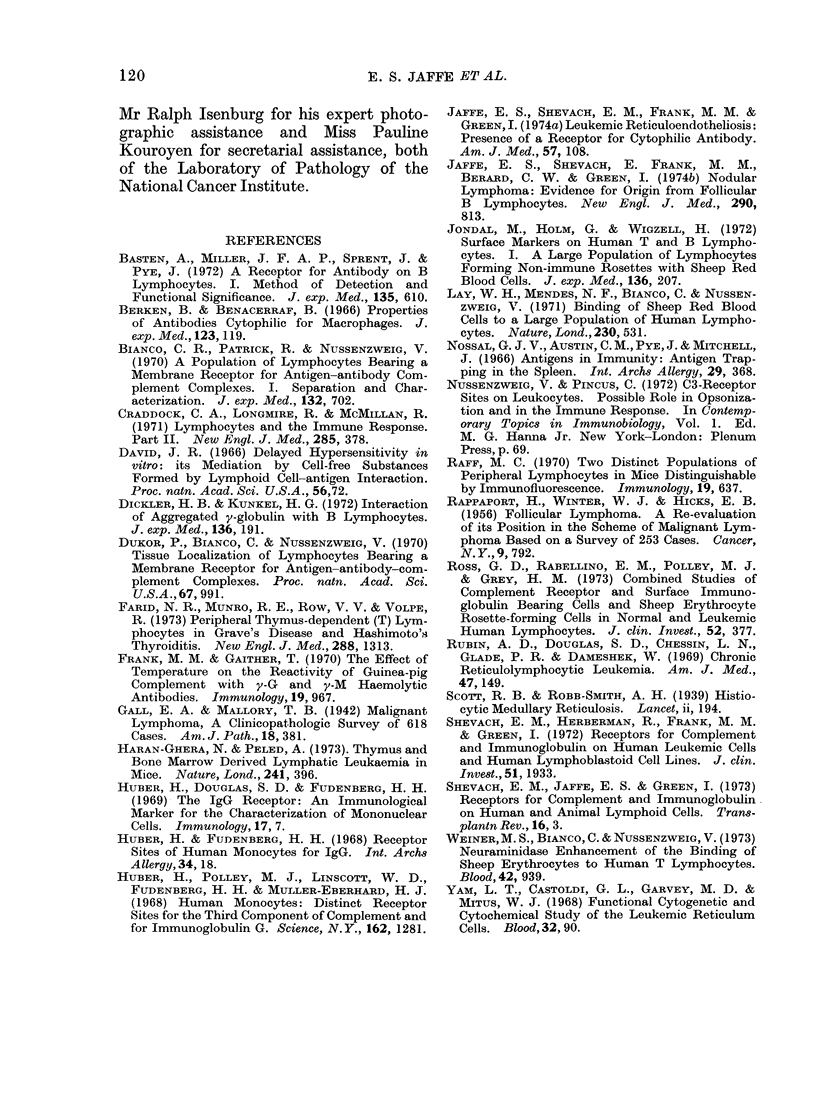Abstract
The cells of the lymphoreticular system are heterogeneous both morphologically and functionally. The bone marrow derived (B) lymphocyte can be identified by the presence of easily detectable surface immunoglobulin and a receptor for antigen-antibody-complement (EAC) complexes. Monocytes and histiocytes also bear a receptor for EAC and in addition possess a receptor for cytophilic antibody detected with red cell--IgG complexes (IgGEA). In man, thymus derived (T) lymphocytes form non-immune rosettes with sheep red blood cells (E). We have examined a number of malignant lymphoreticular populations for the presence of the EAC, EA, and E receptors on suspensions of cells and have adapted the technique to demonstrate the EAC and EA receptors on frozen tissue sections. Rosetted malignant cells can also be cytologically examined on Millipore filters. The malignant cells both in section and suspension from the spleens and lymph nodes of 6 patients with nodular lymphoma bound EAC but not IgGEA or E; by these criteria these malignant cells are of B lymphocytic origin. The malignant cells from the spleens of 2 patients with leukaemic reticuloendotheliosis and 1 patient with malignant histiocytosis could be classified as being of histiocytic origin by the selective binding of IgGEA. In 3 cases of diffuse lymphocytic lymphoma the malignant cells bound only E and are therefore of T lymphocytic origin. The application of these techniques to the classification of malignant lymphoma may lead to important theoretical and therapeutic advances.
Full text
PDF













Images in this article
Selected References
These references are in PubMed. This may not be the complete list of references from this article.
- Basten A., Miller J. F., Sprent J., Pye J. A receptor for antibody on B lymphocytes. I. Method of detection and functional significance. J Exp Med. 1972 Mar 1;135(3):610–626. doi: 10.1084/jem.135.3.610. [DOI] [PMC free article] [PubMed] [Google Scholar]
- Berken A., Benacerraf B. Properties of antibodies cytophilic for macrophages. J Exp Med. 1966 Jan 1;123(1):119–144. doi: 10.1084/jem.123.1.119. [DOI] [PMC free article] [PubMed] [Google Scholar]
- Bianco C., Patrick R., Nussenzweig V. A population of lymphocytes bearing a membrane receptor for antigen-antibody-complement complexes. I. Separation and characterization. J Exp Med. 1970 Oct 1;132(4):702–720. doi: 10.1084/jem.132.4.702. [DOI] [PMC free article] [PubMed] [Google Scholar]
- Craddock C. G., Longmire R., McMillan R. Lymphocytes and the immune response. 2. N Engl J Med. 1971 Aug 12;285(7):378–384. doi: 10.1056/NEJM197108122850705. [DOI] [PubMed] [Google Scholar]
- David J. R. Delayed hypersensitivity in vitro: its mediation by cell-free substances formed by lymphoid cell-antigen interaction. Proc Natl Acad Sci U S A. 1966 Jul;56(1):72–77. doi: 10.1073/pnas.56.1.72. [DOI] [PMC free article] [PubMed] [Google Scholar]
- Dickler H. B., Kunkel H. G. Interaction of aggregated -globulin with B lymphocytes. J Exp Med. 1972 Jul 1;136(1):191–196. doi: 10.1084/jem.136.1.191. [DOI] [PMC free article] [PubMed] [Google Scholar]
- Dukor P., Bianco C., Nussenzweig V. Tissue localization of lymphocytes bearing a membrane receptor for antigen-antibody-complement complexes. Proc Natl Acad Sci U S A. 1970 Oct;67(2):991–997. doi: 10.1073/pnas.67.2.991. [DOI] [PMC free article] [PubMed] [Google Scholar]
- Farid N. R., Munro R. E., Row V. V., Volpé R. Peripheral thymus-dependent (T) lymphocytes in Graves's disease and Hashimoto's thyroiditis. N Engl J Med. 1973 Jun 21;288(25):1313–1317. doi: 10.1056/NEJM197306212882502. [DOI] [PubMed] [Google Scholar]
- Frank M. M., Gaither T. The effect of temperature on the reactivity of guinea-pig complement with gamma G and gamma M haemolytic antibodies. Immunology. 1970 Dec;19(6):967–974. [PMC free article] [PubMed] [Google Scholar]
- Gall E. A., Mallory T. B. Malignant Lymphoma: A Clinico-Pathologic Survey of 618 Cases. Am J Pathol. 1942 May;18(3):381–429. [PMC free article] [PubMed] [Google Scholar]
- HICKS E. B., RAPPAPORT H., WINTER W. J. Follicular lymphoma; a re-evaluation of its position in the scheme of malignant lymphoma, based on a survey of 253 cases. Cancer. 1956 Jul-Aug;9(4):792–821. doi: 10.1002/1097-0142(195607/08)9:4<792::aid-cncr2820090429>3.0.co;2-b. [DOI] [PubMed] [Google Scholar]
- Haran-Chera N., Peled A. Thymus and bone marrow derived lymphatic leukaemia in mice. Nature. 1973 Feb 9;241(5389):396–398. doi: 10.1038/241396a0. [DOI] [PubMed] [Google Scholar]
- Huber H., Fudenberg H. H. Receptor sites of human monocytes for IgG. Int Arch Allergy Appl Immunol. 1968;34(1):18–31. doi: 10.1159/000230091. [DOI] [PubMed] [Google Scholar]
- Huber H., Polley M. J., Linscott W. D., Fudenberg H. H., Müller-Eberhard H. J. Human monocytes: distinct receptor sites for the third component of complement and for immunoglobulin G. Science. 1968 Dec 13;162(3859):1281–1283. doi: 10.1126/science.162.3859.1281. [DOI] [PubMed] [Google Scholar]
- Jaffe E. S., Shevach E. M., Frank M. M., Berard C. W., Green I. Nodular lymphoma--evidence for origin from follicular B lymphocytes. N Engl J Med. 1974 Apr 11;290(15):813–819. doi: 10.1056/NEJM197404112901501. [DOI] [PubMed] [Google Scholar]
- Jondal M., Holm G., Wigzell H. Surface markers on human T and B lymphocytes. I. A large population of lymphocytes forming nonimmune rosettes with sheep red blood cells. J Exp Med. 1972 Aug 1;136(2):207–215. doi: 10.1084/jem.136.2.207. [DOI] [PMC free article] [PubMed] [Google Scholar]
- Lay W. H., Mendes N. F., Bianco C., Nussenzweig V. Binding of sheep red blood cells to a large population of human lymphocytes. Nature. 1971 Apr 23;230(5295):531–532. doi: 10.1038/230531a0. [DOI] [PubMed] [Google Scholar]
- Nossal G. J., Austin C. M., Pye J., Mitchell J. Antigens in immunity. XII. Antigen trapping in the spleen. Int Arch Allergy Appl Immunol. 1966;29(4):368–383. [PubMed] [Google Scholar]
- Raff M. C. Two distinct populations of peripheral lymphocytes in mice distinguishable by immunofluorescence. Immunology. 1970 Oct;19(4):637–650. [PMC free article] [PubMed] [Google Scholar]
- Ross G. D., Rabellino E. M., Polley M. J., Grey H. M. Combined studies of complement receptor and surface immunoglobulin-bearing cells and sheep erythrocyte rosette-forming cells in normal and leukemic human lymphocytes. J Clin Invest. 1973 Feb;52(2):377–385. doi: 10.1172/JCI107194. [DOI] [PMC free article] [PubMed] [Google Scholar]
- Rubin A. D., Douglas S. D., Chessin L. N., Glade P. R., Dameshek W. Chronic reticulolymphocytic leukemia. Reclassification of "leukemic reticuloendotheliosis" through functional characterization of the circulating mononuclear cells. Am J Med. 1969 Jul;47(1):149–162. doi: 10.1016/0002-9343(69)90249-6. [DOI] [PubMed] [Google Scholar]
- Shevach E. M., Herberman R., Frank M. M., Green I. Receptors for complement and immunoglobulin on human leukemic cells and human lymphoblastoid cell lines. J Clin Invest. 1972 Aug;51(8):1933–1938. doi: 10.1172/JCI106999. [DOI] [PMC free article] [PubMed] [Google Scholar]
- Shevach E. M., Jaffe E. S., Green I. Receptors for complement and immunoglobulin on human and animal lymphoid cells. Transplant Rev. 1973;16:3–28. doi: 10.1111/j.1600-065x.1973.tb00115.x. [DOI] [PubMed] [Google Scholar]
- Weiner M. S., Bianco C., Nussenzweig V. Enhanced binding of neuraminidase-treated sheep erythrocytes to human T lymphocytes. Blood. 1973 Dec;42(6):939–946. [PubMed] [Google Scholar]
- Yam L. T., Castoldi G. L., Garvey M. B., Mitus W. J. Functional cytogenetic and cytochemical study of the leukemic reticulum cells. Blood. 1968 Jul;32(1):90–101. [PubMed] [Google Scholar]














